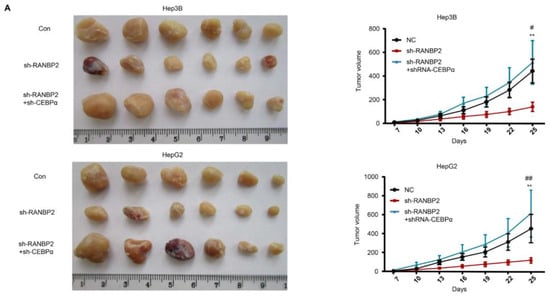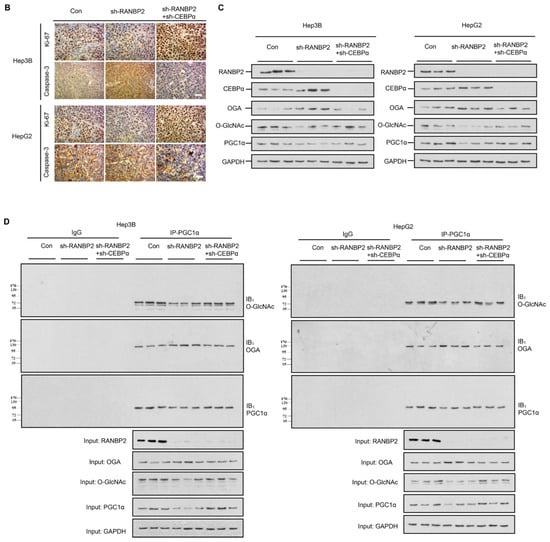In the original publication [1], there was a mistake in Figure 6 as published. We mistakenly exported the wrong IHC results for the “Caspase-3 in HepG2 cell line” shown in Figure 6B. The corrected Figure 6 appears below.


Figure 6.
RANBP2 triggers HCC tumorigenicity via the CEBPα-associated imbalance of O-glycosylation homeostasis in vivo. (A) Silencing of RANBP2 retarded HCC tumor growth, which was effectively counteracted by CEBPα depletion. The sizes of Hep3B and HepG2 tumors formed in the mice with subcutaneous implantation were monitored every three days. Data are presented as the mean ± SD values (n = 6). sh-RANBP2+sh-CEBPα group: * vs sh-RANBP2, ** p < 0.01; # vs NC, # p < 0.05, ## p < 0.01 (t-test). (B) HCC tumorigenicity was confirmed by the immunohistochemical staining of the isolated subcutaneous tumor tissue. sh-RANBP2 significantly decreased the proliferating marker Ki-67, while it increased the apoptosis marker caspase-3. sh-CEBPα was demonstrated to have opposite effects. Scale bars, 20 mm. (C,D) Downstream effectors of RANBP2 and CEBPα related to O-GlcNAc modification and tumor promoter PGC1α were tested by immunoblotting (C) and co-immunoprecipitation (D) in xenograft models.
The authors state that the scientific conclusions are unaffected. This correction was approved by the Academic Editor. The original publication has also been updated.
Reference
- Liu, X.; Chen, X.; Xiao, M.; Zhu, Y.; Gong, R.; Liu, J.; Zeng, Q.; Xu, C.; Chen, X.; Wang, F.; et al. RANBP2 Activates O-GlcNAcylation through Inducing CEBPα-Dependent OGA Downregulation to Promote Hepatocellular Carcinoma Malignant Phenotypes. Cancers 2021, 13, 3475. [Google Scholar] [CrossRef] [PubMed]
Disclaimer/Publisher’s Note: The statements, opinions and data contained in all publications are solely those of the individual author(s) and contributor(s) and not of MDPI and/or the editor(s). MDPI and/or the editor(s) disclaim responsibility for any injury to people or property resulting from any ideas, methods, instructions or products referred to in the content. |
© 2024 by the authors. Licensee MDPI, Basel, Switzerland. This article is an open access article distributed under the terms and conditions of the Creative Commons Attribution (CC BY) license (https://creativecommons.org/licenses/by/4.0/).